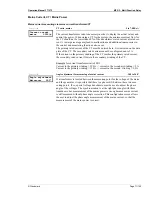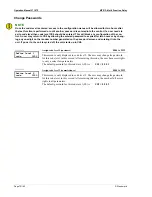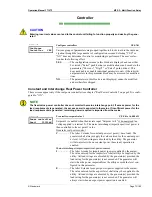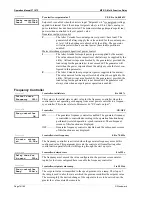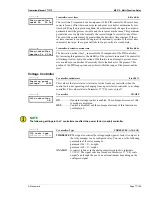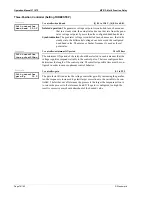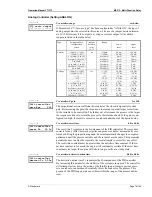
Operation Manual 37107F
MFR 3 - Multi Function Relay
© Woodward
Page 81/165
Three-Position Controller (Setting THREESTEP)
Parameter
67
Pow.fact.contr.
dead band 00.0%
Power factor controller: dead band
0.5 to 25.0 %
The unit automatically calculates the amount of re-active power, which is required
to maintain the configured power factor. In mains parallel operation, the re-active
power is controlled in such a manner, that in its steady state, the actual value does
not deviate from the internally calculated percentage set point (set point 1) value by
more than the configured dead band. In this case, the percentage value refers to the
generator rated power.
Parameter
68
Pow.fact.contr.
gain Kp 00.0
Power factor controller: gain
0.1 to 99.9
The gain factor K
P
indicates the power factor controller gain. By increasing the
gain factor, the response is increased to permit larger corrections to the variable to
be controlled. The farther out of tolerance the process is the larger the response ac-
tion is to return the process to the tolerance band. If the gain is configured too high,
the result is excessive overshoot/undershoot of the desired value.
Analog Controller (Setting ANALOG)
Parameter
69
Pow.fact.contr.
gains Kpr 000
Power factor controller: P gain
1 to 240
The proportional-action coefficient K
PR
indicates the closed-loop control system
gain. By increasing the gain, the response is increased to permit larger corrections
to the variable to be controlled. The farther out of tolerance the process is the larger
the response action is to return the process to the tolerance band. If the gain is con-
figured too high, the result is excessive overshoot/undershoot of the desired value.
Parameter
70
Pow.fact.contr.
reset Tn 00.0s
Power factor controller: reset time
0.0 to 60.0 s
The reset time T
n
represents the I-component of the PID controller. The reset time
corrects for any offset (between set point and process variable) automatically over
time by shifting the proportioning band. Reset automatically changes the output re-
quirements until the process variable and the set point are the same. This parameter
permits the user to adjust how quickly the reset attempts to correct for any offset.
The reset time constant must be greater than the derivitive time constant. If the re-
set time constant is too small, the engine will continually oscilate. If the reset time
constant is too large, the engine will take to long to settle at a steady state.
Parameter
71
Pow.fact.contr.
derivat.Tv 0.00s
Power factor controller: derivative-action time
0.00 to 6.00 s
The derivative-action time T
V
represents the D-component of the PID controller.
By increasing this parameter, the stability of the system is increased. The controller
will attempt to slow down the action of the throttle in an attempt to prevent exces-
sive overshoot
or undershoot. Essentially this is the brakes for the process. This
portion of the PID loop operates anywhere within the range of the process unlike
reset.





